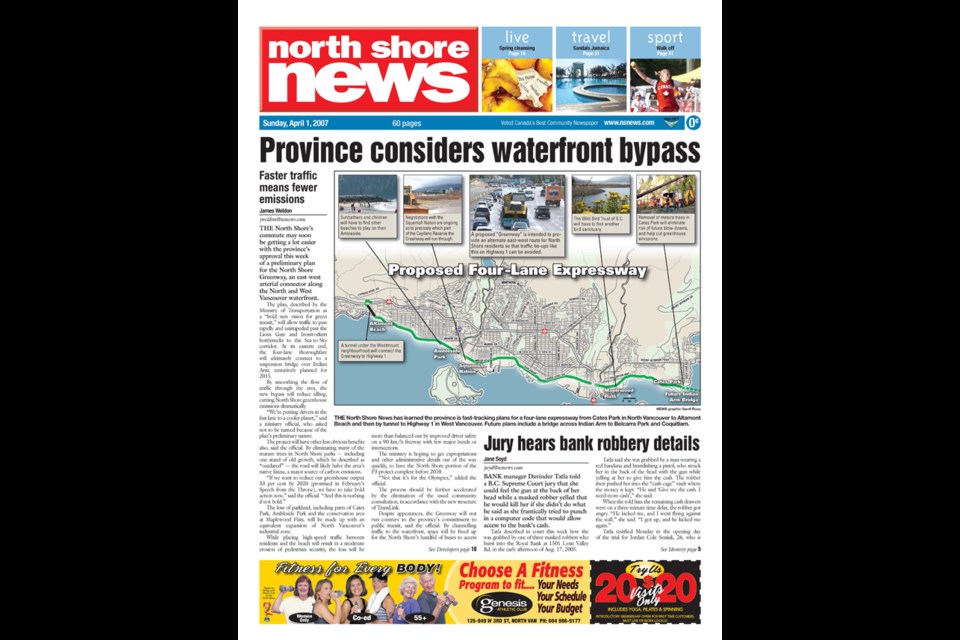The North Shore News editorial team prides itself on dogged reporting, getting to the bottom of what’s really going on at city hall, provincial court or anywhere in between. We’re looking for the truth.
Well … most of the time we are looking for the truth. One day a year, however, we might take a few liberties, add in a touch of creative embellishment. Or, perhaps, we’ll completely make something up.
Media organizations have a long tradition of running fake news stories as April Fools’ Day pranks, and we here at the News sometimes can’t resist a good whopper. The North Shore News used to publish three times a week, now two, meaning that we don’t have a hard-copy paper hitting the streets every April 1. But when we do, you might need to read with a little extra scepticism.
One year we wrote about West Vancouver’s new “housing reduction strategy,” a policy to eliminate houses to give current residents “a little more elbow room.” Funnily enough, the next census revealed that West Vancouver actually did have a net loss in the number of dwellings that year.
Other early April exposés revealed a plan to put turnstiles on backcountry trails, a Mount Rushmore-like sculpture featuring B.C. premiers on Eagleridge Bluffs, and a new North Shore municipality dubbed the District of East North Vancouver.
Below we’ve reprinted a story, written by reporter James Weldon, that we published on the front page on April 1, 2007. It came in quite a convincing package, complete with a very official-looking illustration drawn up by one of the paper’s graphic designers.
This one fooled a lot of people, including a provincial minister who left us an angry phone message only to call back later with a more sheepish response.
Would you have been fooled? Give it a read, and try to decide where the reasonable becomes the ridiculous:
Province considers waterfront bypass ; Faster traffic means fewer emissions
James Weldon
April 1, 2007
The North Shore’s commute may soon be getting a lot easier with the province’s approval this week of a preliminary plan for the North Shore Greenway, an east-west arterial connector along the North and West Vancouver waterfront.
The plan, described by the Ministry of Transportation as a “bold new vision for green transit,” will allow traffic to pass rapidly and unimpeded past the Lions Gate and Ironworkers bottlenecks to the Sea-to-Sky corridor. At its eastern end, the four-lane thoroughfare will ultimately connect to a suspension bridge over Indian Arm, tentatively planned for 2015.
By smoothing the flow of traffic through the area, the new bypass will reduce idling, cutting North Shore greenhouse emissions dramatically.
“We’re putting drivers in the fast lane to a cooler planet,” said a ministry official, who asked not to be named because of the plan’s preliminary nature.
The project will have other less obvious benefits also, said the official. By eliminating many of the mature trees in North Shore parks -- including one stand of old growth, which he described as “outdated” -- the road will likely halve the area’s native fauna, a major source of carbon emissions.
“If we want to reduce our greenhouse output 33 per cent by 2020 (promised in February’s Speech from the Throne), we have to take bold action now,” said the official. “And this is nothing if not bold.”
The loss of parkland, including parts of Cates Park, Ambleside Park and the conservation area at Maplewood Flats, will be made up with an equivalent expansion of North Vancouver’s industrial zone.
While placing high-speed traffic between residents and the beach will result in a moderate erosion of pedestrian security, the loss will be more than balanced out by improved driver safety on a 90 km/h freeway with few major bends or intersections.
The ministry is hoping to get expropriations and other administrative details out of the way quickly, to have the North Shore portion of the P3 project complete before 2010.
“Not that it’s for the Olympics,” added the official.
The process should be further accelerated by the elimination of the usual community consultation, in accordance with the new structure of TransLink.
Despite appearances, the Greenway will not run contrary to the province’s commitment to public transit, said the official. By channelling traffic to the waterfront, space will be freed up for the North Shore’s handful of buses to access commuter routes.
“It’s similar to the logic of starving funding to the Evergreen Line in favour of expanding highways,” said the official. Fast-tracking that project or other mass transit proposals would have been “an environmental catastrophe.”
North Shore developers contacted by the News expressed cautious support for the proposal. While it is unclear how it will impact them -- if at all -- several have submitted requests for density bonusing “just to be safe.”
The plan’s final draft is expected one year from today: April 1, 2008. ◆
This story was included in our 50th Anniversary Issue, published Wednesday, Aug. 14, 2019. Click here for more stories from this special edition of the North Shore News.



